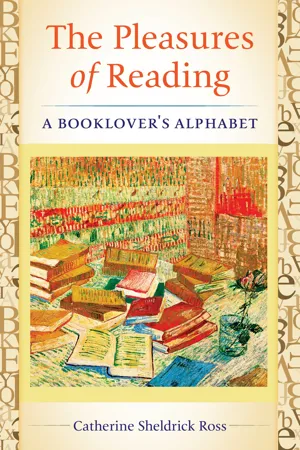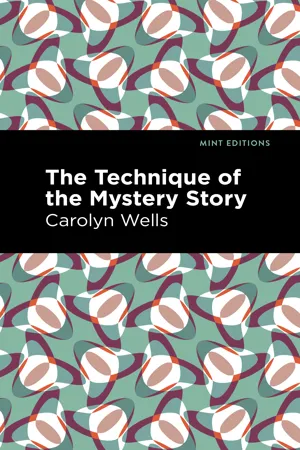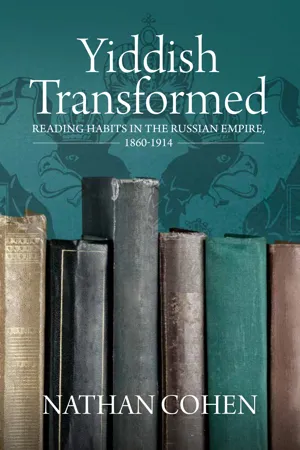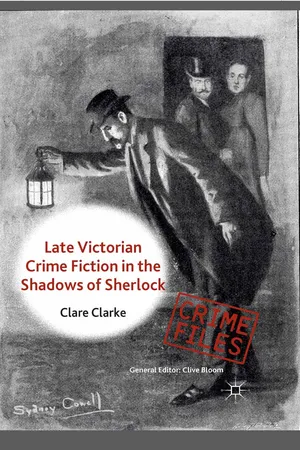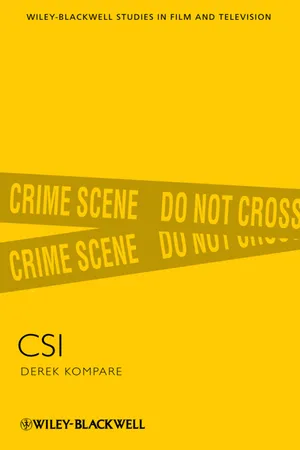Literature
Detective Fiction
Detective fiction is a genre of literature that revolves around a central mystery, often a crime, and the efforts of a detective or amateur sleuth to solve it. The genre is characterized by its focus on the process of investigation, the unraveling of clues, and the revelation of the truth. Detective fiction often features a protagonist with keen observational and deductive skills.
Written by Perlego with AI-assistance
Related key terms
Related key terms
1 of 4
Related key terms
1 of 3
6 Key excerpts on "Detective Fiction"
- eBook - ePub
The Pleasures of Reading
A Booklover's Alphabet
- Catherine Sheldrick Ross(Author)
- 2014(Publication Date)
- Libraries Unlimited(Publisher)
D
Detective, Mystery, and Crime Fiction
Of all the popular genres, Detective Fiction is the one about which readers have felt the least guilt in reading. When academics and serious writers seek out leisure reading, they often choose detective stories, mysteries, or crime novels as they are variously called. They also write them, and they write about them. Although Dorothy L. Sayers considered her translation of Dante’s Divine Comedy to be her most important work, she is remembered and loved mostly for her Detective Fiction featuring Lord Peter Wimsey and Harriet Vane. With readers generally, the mystery genre is in the top two or three most popular genres of fiction (Createc 2005). Mystery fans often say that they first got turned on to the genre in childhood, reading Nancy Drew , the Hardy Boys , Encyclopedia Brown , or even Agatha Christie, and they never stopped (Clark 2008, 166–67). Once hooked on mystery stories in childhood, they just keep on reading them, moving on to grown-up versions of the genre they had enjoyed in childhood. Devoted mystery readers are aware of the various subgenres—cozies, hard-boiled, serial killers, historical, police procedurals, and paranormal mysteries. Some may read selectively across the whole continuum, and they may also read the related, but distinct, genres of the thriller, the spy novel, and romantic suspense. From wide exposure to crime novels as well as to crime movies and television series, readers have a well-elaborated mental model of the various conventions used in their favorite subgenres.The Bargain between Reader and Writer
In general, mystery readers know what to expect when they pick up a detective story. As Elizabeth (PhD candidate in English, age 35) said, “You know exactly what you’re getting. The bargain between the reader and the writer is very clear.” A murder has been committed, and the reader is involved, along with the detective, in sifting through clues to uncover a hidden, anterior story that happened before the detective arrives on the scene. As Frank Kermode (1983, 56) puts it, “The detective story is much more concerned than narratives normally are with the elucidation of a series of events which closed either before or only shortly after its own starting point.” The writer needs to provide all the evidence concerning the truth of those earlier events but do so in a way that keeps the reader guessing right to the end. Much of the mystery reader’s engagement is hermeneutic, involved with the interpretation of signs and clues. Bulgarian narratologist Tzvetan Todorov (1977) has pointed out that the classic detective story is really two stories. There is the hidden story of the crime, which the detective is trying to piece together from the available evidence, working from effect to cause. Then there is the story of the investigation itself, which works toward the unmasking of the murderer. As the novelist David Lodge (2006, 260) observes, “The second story is often reported by a friend of the detective (e.g., Watson) who acknowledges that he is writing it, while the story of the crime never admits its literariness.” - Carolyn Wells(Author)
- 2021(Publication Date)
- Mint Editions(Publisher)
VIDETECTIVE STORIES
What Is a Detective Story Rise of the Detective Story The Detective—Fictive and Real Fiction versus Fact The Interest of the Detective Story A Summing Up1. What is a Detective Story?
THE CLASS OF FICTION WHICH we shall group under this head must include all stories where the problem is invented and solved by the author and set forth in such a way as to give an astute reader opportunities for guessing or reasoning out the answer.
An actual detective need not necessarily figure in the story, but detective work must be done by some of the characters.There must be crime or apparent crime or attempted crime. But whether the problem is one of murder, robbery or kidnapping,—whether it be solved by evidence, deduction or a cryptogram,—it is detected, not guessed, and this is the main element in our classification.The average or typical Detective Story of today is the detailed narrative of the proceedings of an individual of unusual mental acumen in unraveling a mystery.Strictly speaking, a detective is a member of the police organization or of a private detective agency. But for fictional purposes he may be such, or he may be anyone with what is called “detective instinct” or a taste for detective work.It appears that in its earliest days the word “detective” meant merely a shadower or follower. A curious old story in Harper’s Magazine for 1870 begins thus:The remarkable skill and penetration shown by our modern detectives in “shadowing” suspected persons until sufficient proof has been obtained to warrant their arrest is illustrated by the daily history of crime. By the term “shadowing” is meant that vigilant watch kept upon the culprit by someone who follows him like his own shadow, and to do this successfully indicates no small degree of skill on the part of the “detective.” This last expression recalls to memory some strange facts which came to my knowledge in the early part of my life, and I can never meet the term in print or hear it in conversation without a painful reminiscence.- eBook - ePub
Yiddish Transformed
Reading Habits in the Russian Empire, 1860-1914
- Nathan Cohen(Author)
- 2023(Publication Date)
- Berghahn Books(Publisher)
CHAPTER 3
New on the Shelf
Crime and Detective StoriesCrime Stories for the Masses
In the first decade of the twentieth century, the varied range of Yiddish books included, among other genres and styles, crime and detective stories, which at a certain stage became bestsellers.1 This chapter discusses these publications, which were mostly adapted or translated from other languages and have so far attracted little scholarly attention.As a result of the difficulty in reaching a detailed definition of mystery novels, police stories, thrillers, spy, and Detective Fiction, scholars of these literary genres prefer the more inclusive term “crime stories (or novels),” within the framework of which they subsequently distinguish between different types of writing.2 In Western Europe and America, crime stories of various genres were generally considered a branch of sensational literature: readers encounter different levels and scopes of violent acts under the guise of mystery. Such stories are guided by one or more questions—“who,” “why,” “how”—and keep readers in suspense until the mystery is solved and the guilty party/parties punished.In the second half of the nineteenth century, writers typically drew the raw material for many of these works from the pages of popular daily newspapers as well as urban, at times also familial, situations familiar to all (unlike the forests or isolated castles characteristic of the sensational and fantastical adventures that were popular before the advent of crime stories). The range of crime stories includes works of high literary quality, attesting to their authors’ writing abilities, alongside trivial works devoid of any literary value. Consumption of crime stories traverses the borders of gender and social class; such works at once attempt to contend with the evil lurking around every corner and inspire confidence in the eventual triumph of the good and righteous.3 In fact, some crime stories composed in Western and Central Europe in the first half of the nineteenth century raised the criminal to the status of a hero, leading readers to identify with him, while at the same time criticizing social injustices, which unintentionally nurture crime and violence.4 - C. Clarke(Author)
- 2014(Publication Date)
- Palgrave Macmillan(Publisher)
2 My study offers an alternative, and much fuller, account of late Victorian crime fiction, concentrating particularly on the frequently overlooked stories which illustrate the nascent genre’s often overlooked capacity for narrative and moral complexity. It examines a selection of stories where detectives are criminals and murderers, where criminals are heroes, or where crimes go unsolved. Arthur Conan Doyle’s canonical Sherlock Holmes stories and Robert Louis Stevenson’s novels are considered alongside works by neglected authors Fergus Hume, Israel Zangwill, Arthur Morrison and Guy Boothby. Together these fascinating ‘Shadows of Sherlock’ showcase the often wholly overlooked formal and moral diversity of late Victorian crime writing, forcing us to rethink our preconceptions about what the nineteenth-century detective genre is and does.The detective genre is generally taken to have been born in the USA of the 1840s, with Edgar Allan Poe’s short stories, ‘The Murders in the Rue Morgue’ (1841), ‘The Mystery of Marie Rogêt’ (1842) and ‘The Purloined Letter’ (1844), starring the investigative hero Chevalier Auguste Dupin. British literature featuring detection by police constables, such as Charles Dickens’s Bleak House (1852–53) and Wilkie Collins’s The Moonstone (1868), appeared later in the nineteenth century, following the 1842 formation of London’s Detective Department of the Metropolitan police. In the 1860s, French writer Emile Gaboriau’s Monsieur Lecoq stories, based on the adventures of real-life criminal-turned-detective Eugène François Vidocq, sold in huge numbers worldwide. The 1880s and 1890s, however, were the years in which British Detective Fiction firmly established itself as a genre in its own right and sealed its popularity with the reading public.This appetite for detective stories doubtless is due at least in part to the emergence during this period of Arthur Conan Doyle’s Sherlock Holmes novels A Study in Scarlet (1887) and The Sign of Four (1890) and short stories, which were originally published in The Strand Magazine (1891–92) and later collected as The Adventures of Sherlock Holmes (1892) and The Memoirs of Sherlock Holmes (1893). Whilst the Holmes novels sold slowly, the stories for The Strand famously captured the imagination of the late Victorian reading public straight away, elevating the magazine’s already decent sales figures to over 500,000 copies per issue (Brake and Demoor 604). To put this in context, Marie Corelli’s The Sorrows of Satan (1895), which is often called the bestselling novel of the late Victorian era, sold around 100,000 copies per year (Ferguson 67). Holmes is not the whole story of the late Victorian detective genre, however. The generic and formal features which came to dominate late Victorian crime fiction did not begin with the publication of Doyle’s A Study in Scarlet (1887), nor were they secured fully by the Strand- eBook - ePub
American TV Detective Dramas
Serial Investigations
- Mareike Jenner(Author)
- 2016(Publication Date)
- Palgrave Macmillan(Publisher)
3 Defining Detection: The Detective GenreThis chapter frames the analysis of the American television detective drama through genre. It will first give an outline of the relationship between the crime genre and the detective genre, and will then move on to discuss two of the detective genre’s sub-genres: the ‘genius’ detective genre and the police procedural. In the course of outlining and defining the genre, this chapter will also sketch out an understanding of genre as discourse, following the work of Jason Mittell (2004). The discussion of how the genre is understood here serves several purposes. First, the different ways in which the detective genre has been debated in relation to various media makes it necessary to offer a clear terminology for this discussion. Furthermore, as this chapter will show, the definition of the detective genre is complicated by the sub-genre’s relationship with the crime genre. The crime genre describes all texts that feature crime as a dominant part of the narrative (the gangster genre, the serial killer genre, the cop drama, the heist film, the courtroom drama, etc.). It is treated here as an umbrella term or umbrella genre that accommodates a number of sub-genres, as will be discussed in more detail later on. Second, with a prolific genre like the detective genre, which is not exclusive to one media form, it becomes relevant to discuss similarities and differences between versions on television and other media in its aesthetics and narrative structures. These formal aspects and the television genre’s links to the literary genre are discussed throughout this study, but need to be underpinned by clear definitions.To briefly define the detective genre, it is understood here as a sub-genre of the crime genre. As self-explanatory as the term ‘crime genre’ seems, there is some confusion over what actually constitutes it. Most approaches to the genre, whether in literature, film or television studies, work with very vague definitions. A common denominator is that a serious crime (or the appearance of one) lies at the centre of the narrative. This inclusive approach to genre has its advantages: it acknowledges the fluidity of any genre definition and can easily deal with generic hybrids like Analyze This (dir. Ramis 1999), which is a gangster film as well as a comedy. But the stories of crime can be told from various angles: The Godfather (dir. Coppola 1972) or L.A. Confidential (dir. Hanson 1997) are not films about ‘a crime’, but tell stories of criminal conspiracies, with the earlier film telling the story from the perspective of the criminal(s). A film like Philadelphia (dir. Demme 1993) deals with the issue of whether a crime has been committed, and parts of the film deal with the investigation of this crime. But the crime is wrongful termination – a serious crime, indeed, but rarely the stuff of crime stories – and the emphasis of the film is on melodrama. Films like Lethal Weapon (dir. Donner 1987) or Tango and Cash (dir. Konchalovskiy 1989) have the investigation of crimes at their centre, but narrative structures, point of view and the moments of ‘spectacle’ are different from those in the other texts. These examples are all from film, but the crime genre becomes even broader with the inclusion of novels ranging from Cop Hater (McBain 1956) to The Firm (Grisham 1991) or The Judge and His Hangman (Dürrenmatt 1951), or television dramas ranging from Murder, She Wrote to The Shield to more melodramatic series like Judging Amy (CBS, 1999–2005). The term ‘crime genre’ is also often used synonymously with its many sub-genres. For example, in an article on CSI: Crime Scene Investigation - eBook - ePub
- Derek Kompare(Author)
- 2011(Publication Date)
- Wiley-Blackwell(Publisher)
Accordingly, with such public and private consequences indicated by its very definition, crime has long fueled the interest of outside observers. While there are many historical and mythical antecedents, this interest becomes particularly active alongside modernity, beginning in the eighteenth century, when accounts of prison confessions, detailing crimes in graphic detail, were first published in books and periodicals. These precursors, to what we today refer to as “true crime” narratives, indicate a strong relationship between crime, spectacle (even in the written word alone), narrative, and official and popular consumption. In other words, crime began to function as both a category of State power and mass entertainment. By the mid nineteenth century, fictional crime stories clearly inspired by these accounts began to be published, detailing not only crimes but also their investigations by interested or official authorities. As John Scaggs describes in his history of crime fiction, the “rational detective,” first seen in the Dupin stories of Edgar Allan Poe in the 1840s, is a particularly modern character, schooled in the actions, objects and methods of post-Enlightenment civilization, and most often ensconced in its legal and moral codes, as well as its bureaucracy (2005: 33–49). Appearing in society virtually simultaneously with organized police departments, and replacing the clerical or royal decree of crime with intensive observation and logical deduction, detectives, even amateur or independent ones, were represented as agents of modernity in literature, solving crimes and reasserting the prevailing moral and social order, however contentious that may be.Moreover, they did so increasingly through the new theories and tools of forensic science, including photography, fingerprinting, and even lie detectors: all modern technologies and methods ostensibly designed to identify criminal individuals. As Ronald R. Thomas notes in his study of the concomitant rise of Detective Fiction and forensic criminology, the “detective narrative, in its deployment of these forensic technologies and in its resemblance to them, helped to make nineteenth-century persons legible for a modern technological culture” (1999: 17). This burgeoning “modern technological culture” of the late nineteenth and early twentieth centuries was defined by the new technologies and scientific methods of visibility. Technologies like photography, cinematography, and sound recording created new registers of spectacle, freezing in time and space moments – like Eadweard Muybridge’s famous 1878 photos of Leland Stanford’s galloping horse – that were once only fleeting, and disseminating mass-produced copies to far-flung viewers and listeners. Similarly, rapidly developing fields like biology, medicine, chemistry, and physics had begun to re-envision the world as a rational system of signs that could be made visible through increasingly precise scientific methods of experimentation and observation. By the beginning of the twentieth century, these practices, theories, and devices had redefined the world, down to the atom, as the realm of the visible.
Index pages curate the most relevant extracts from our library of academic textbooks. They’ve been created using an in-house natural language model (NLM), each adding context and meaning to key research topics.
Explore more topic indexes
Explore more topic indexes
1 of 6
Explore more topic indexes
1 of 4
